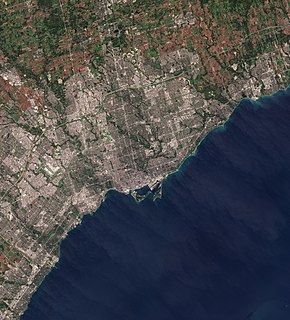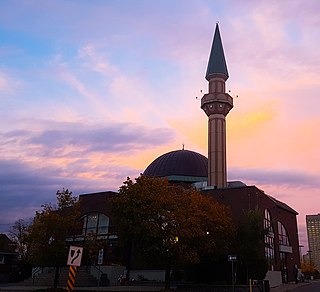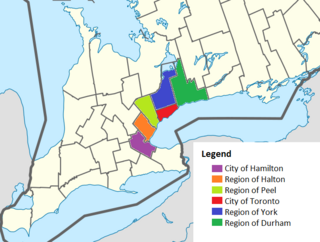Related Research Articles

Toronto is the capital city of the Canadian province of Ontario. With a recorded population of 2,794,356 in 2021, it is the most populous city in Canada and the fourth most populous city in North America. The city is the anchor of the Golden Horseshoe, an urban agglomeration of 9,765,188 people surrounding the western end of Lake Ontario, while the Greater Toronto Area proper had a 2021 population of 6,712,341. Toronto is an international centre of business, finance, arts, and culture, and is recognized as one of the most multicultural and cosmopolitan cities in the world.

Markham is a city in the Regional Municipality of York, Ontario, Canada. It is approximately 30 km (19 mi) northeast of Downtown Toronto. In the 2021 Census, Markham had a population of 338,503, which ranked it the largest in York Region, fourth largest in the Greater Toronto Area (GTA), and 16th largest in Canada.

Oakville is a town in Halton Region, Ontario, Canada. It is located on Lake Ontario between Toronto and Hamilton. At its 2021 census population of 213,759, it is Ontario's largest town. Oakville is part of the Greater Toronto Area, one of the most densely populated areas of Canada.

Vaughan is a city in Ontario, Canada. It is located in the Regional Municipality of York, just north of Toronto. Vaughan was the fastest-growing municipality in Canada between 1996 and 2006 with its population increasing by 80.2% during this time period and having nearly doubled in population since 1991. It is the fifth-largest city in the Greater Toronto Area, and the 17th-largest city in Canada.

Chinese Canadians are Canadians of full or partial Chinese ancestry, which includes both naturalized Chinese immigrants and Canadian-born Chinese. They comprise a subgroup of East Asian Canadians which is a further subgroup of Asian Canadians. Demographic research tends to include immigrants from Mainland China, Taiwan, Hong Kong, and Macau, as well as overseas Chinese who have immigrated from Southeast Asia and South America into the broadly defined Chinese Canadian category.

The Greater Toronto Area, commonly referred to as the GTA, includes the City of Toronto and the regional municipalities of Durham, Halton, Peel, and York. In total, the region contains 25 urban, suburban, and rural municipalities. The Greater Toronto Area begins in Burlington in the Halton Region, and extends along Lake Ontario past downtown Toronto eastward to Clarington in the Durham Region.

Islam is the second largest religion in Canada. Muslims have lived in Canada since 1871 and the first mosque was established in 1938. Most Canadian Muslims are Sunni, while a significant minority are Shia and Ahmadiyya. There are a number of Islamic organizations and seminaries (madrasas). Opinion polls show most Muslims feel "very proud" to be Canadians, and attend mosque at least once a week.

The Regional Municipality of Halton, or Halton Region, is a regional municipality in Ontario, Canada, located in the Golden Horseshoe of Southern Ontario. It comprises the city of Burlington and the towns of Oakville, Milton, and Halton Hills. The region provides policing by the Halton Regional Police Service. The regional council's headquarters are located in Oakville. Burlington and Oakville are largely urban and suburban, while the towns of Milton and Halton Hills are more rural.

Filipino Canadians are Canadians of Filipino descent. Filipino Canadians are the fourth largest subgroup of the overseas Filipinos and one of the fastest-growing groups in Canada.
Latin Americans, are the citizens of Latin American countries. Latin American countries and their diasporas are multi-ethnic and multi-racial. Latin Americans are a pan-ethnicity consisting of people of different ethnic and national backgrounds. As a result, some Latin Americans do not take their nationality as an ethnicity, but identify themselves with a combination of their nationality, ethnicity and their ancestral origins. Aside from the Indigenous Amerindian population, all Latin Americans have some Old World ancestors who arrived since 1492. Latin America has the largest diasporas of Spaniards, Portuguese, black Africans, Italians, Lebanese and Japanese in the world. The region also has large German, French, Palestinian, Chinese and Jewish diasporas.

Buddhism is among the smallest minority-religions in Canada, with a very slowly growing population in the country, partly the result of conversion, with only 4.6% of new immigrants identifying themselves as Buddhist. As of 2011, the census recorded 366,830 or 1.1% Canadian Buddhists.
A visible minority is defined by the Government of Canada as "persons, other than aboriginal peoples, who are non-Caucasian in race or non-white in colour". The term is used primarily as a demographic category by Statistics Canada, in connection with that country's Employment Equity policies. The qualifier "visible" was chosen by the Canadian authorities as a way to single out newer immigrant minorities from both Aboriginal Canadians and other "older" minorities distinguishable by language and religion, which are "invisible" traits.
Iranian Canadians or Persian Canadians are citizens of Canada whose national background is traced from Iran or are people possessing Iranian and Canadian dual citizenship. From the 2016 Canadian census, the main communities can be found in Southern Ontario, British Columbia, and Quebec. The vast majority, however, live in northern suburbs of Toronto such as Richmond Hill, Vaughan, Markham, and Thornhill, and in certain municipalities of Vancouver, including North Vancouver, West Vancouver, Burnaby, and Coquitlam. As of 2016 a total of 97,110 Iranians reside in the Greater Toronto Area, 46,255 in the Greater Vancouver Area, and 23,410 in the Greater Montreal Area, with the remainder spread out in the other major cities of Canada, based on the 2016 Canadian Census. These numbers represent the people who stated "Iranian" as their single or joint ethnic origin in the census survey.
The demographics of Toronto, Ontario, Canada make Toronto one of the most multicultural and multiracial cities in the world. In 2016, 51.5 percent of the residents of the city proper belonged to a visible minority group, compared with 49.1% in 2011, and 13.6% in 1981. Toronto also has established ethnic neighbourhoods such as the multiple Chinatowns, Corso Italia, Little Italy, Little India, Greektown, Koreatown, Little Jamaica, Little Portugal and Roncesvalles, which celebrate the city's multiculturalism. Data from the suburban municipalities are also included for some metrics as most of these municipalities are part of the Toronto CMA.
Ballantrae, Ontario is a hamlet in the Town of Whitchurch–Stouffville. Named after the village of Ballantrae in South Ayrshire, Scotland, the community is centred on the intersection of Aurora Road and Highway 48.

Asian Canadians are Canadians who can trace their ancestry back to the continent of Asia or Asian people. Canadians with Asian ancestry comprise both the largest and fastest growing group in Canada, after European Canadians, with roughly 17.7% of the Canadian population. Most Asian Canadians are concentrated in the urban areas of Southern Ontario, Southwestern British Columbia, Central Alberta, and other large Canadian cities.
Asian people are the people of Asia. The term may also refer to their descendants.

The Greater Toronto and Hamilton Area (GTHA) is a contiguous urban region that is composed of some of the largest cities and metropolitan areas by population in the Canadian province of Ontario. The GTHA consists of the Greater Toronto Area (GTA) and the city of Hamilton. The GTA is Canada’s most populous metropolitan area that includes the city of Toronto and the regional municipalities of Halton, Peel, York, and Durham. The GTHA forms the core of a larger urban agglomeration known as the Golden Horseshoe.

Racism in Canada traces both historical and contemporary racist community attitudes, as well as governmental negligence and political non-compliance with United Nations human rights standards and incidents in Canada. Contemporary Canada is the product of indigenous First Nations combined with multiple waves of immigration, predominantly from Asia and Europe.
References
- ↑ Visible minority' will mean 'white' by 2031, TheStar.com, 03.10.2010
- ↑ Projections of the diversity of the Canadian population, Statistics Canada Archived 2011-07-06 at the Wayback Machine , 03.09.2010
- ↑ Ethnic population distribution in Ontario Archived 2010-11-25 at the Wayback Machine , fisherbill.com